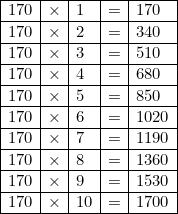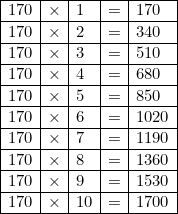Table of 170
Introduction
The maths table is a key idea in mathematics that teaches pupils how to determine a number's multiples. We have been taught multiplication tables since primary school. These maths tables assist us in solving multiplication problems quickly. It is consequently vital for pupils to memorise maths tables in order to solve complex calculations rapidly. Let's review the 170 maths tables and some tips for remembering them.
Maths Tables
Elementary arithmetic equations are essential in our daily lives. Using calculators for simple calculations may impair your understanding of scales and enormities. Aside from your preparation, speed and accuracy are critical in competitive tests. Even if calculators are permitted, students with superior mathematical skills will always have an advantage over students who rely on calculators for basic calculations.
Mathematical tables are necessary for grasping mathematics. Students are advised to have a firm grasp of maths tables; otherwise, understanding the other areas of mathematics would be difficult. Students will likely struggle with basic maths concepts such as decimals, percentages, fractions, ratios, and so on if they do not have elementary knowledge of maths tables. Once you've learned these multiplication tables, you'll remember them for the rest of your life.
Historical Development of Tables
Ancient Babylonian multiplication tables are most likely the first to have been developed over 4,000 years ago. They performed their maths on clay tablets, some of which have endured until today. As their civilisation advanced, they needed to perform ever-more complex mathematical calculations to aid in building and commerce.
Merchants would carry tablets with these multiplication tables in their wallets to speed up calculations, just like engineers carry calculators. Trading was more successful for individuals who knew these tablets by heart than those who had to draw out the pills. However, remember the ancient Babylonian students. In the past, they counted in powers of 60 rather than the forces of 10 we use today, so they had to learn their sums for their 59 times table.
Solved Examples
1.What is the table of 170
Ans. \begin{array}{|l|l|l|l|l|}\hline 170 & \times & 1 & = & 170 \\\hline 170 & \times & 2 & = & 340 \\\hline 170 & \times & 3 & = & 510 \\\hline 170 & \times & 4 & = & 680 \\\hline 170 &\times & 5 & = & 850 \\\hline 170 & \times & 6 & =&1020 \\\hline 170 & \times & 7 & = &1190 \\\hline 170 & \times & 8 &= &1360 \\\hline 170 & \times &9& = & 1530 \\\hline 170 & \times &10& = & 1700 \\\hline\end{array}

2. What are the 170 times tables?
Ans: 170 is multiplied by all natural numbers in the 172 times table. Starting with \begin{equation}170 \times 2=340\end{equation} , move on to ![]()
![]() \begin{equation}170 \times 2=340\end{equation} .
\begin{equation}170 \times 2=340\end{equation} .
3. Find the sum of the first ten multiples of 170.
Ans: The first ten multiples of 170 are: 370, 510, 680, 850, 1020, 1190, 1360, 1530, and 1700.
4. Which of the following numbers are multiples of 170? 510, 753, 1190, 1676, 2720, and 2983?
Ans: When 510, 753, 1190, 1676, 2720, and 2983 are divided by 170, the remainders are 0, 73, 0, 146, 0, and 93. Thus, the multiples of 170 are 510, 1190, and 2720.
5. Determine whether 467 is a multiple of 170.
Ans: 467 divided by 170, and it gives a remainder of 127. 467 is not a multiple of 170.
Multiplication table of 170
You may learn multiplication for 170 through 20 times with the help of this 170 times multiplication table. 170 divided by 1 is 170, and 170 divided by 20 is 3400. This table is more beneficial for students and kids learning the one hundred and seventy multiplication table.
\begin{array}{|l|l|l|l|l|}\hline 170 & \times & 1 & = & 170 \\\hline 170 & \times & 2 & = & 340 \\\hline 170 & \times & 3 & = & 510 \\\hline 170 & \times & 4 & = & 680 \\\hline 170 &\times & 5 & = & 850 \\\hline 170 & \times & 6 & =&1020 \\\hline 170 & \times & 7 & = &1190 \\\hline 170 & \times & 8 &= &1360 \\\hline 170 & \times &9& = & 1530 \\\hline 170 & \times &10& = & 1700 \\\hline\end{array}

Frequently Asked Questions (FAQs)
The number 170 is not a perfect square. 170's square root is 13.0384 as a result.
170 is a composite number because it has more than two factors.
1, 2, 17 and 34 are shared by the numbers 170 and 238. Since 34 is the greatest of the common factors, the HCF for 170 and 238 would be 34.
1, 2, 5, 10, 17, 34, 85, and 170 make up 170. Thus, there are eight factors in 170.
The factors of 170 are 2, 5, and 7.
Applications for Admissions are open.
As per latest syllabus. Physics formulas, equations, & laws of class 11 & 12th chapters
JEE Main Important Chemistry formulas
Get nowAs per latest syllabus. Chemistry formulas, equations, & laws of class 11 & 12th chapters
JEE Main high scoring chapters and topics
Get nowAs per latest 2024 syllabus. Study 40% syllabus and score upto 100% marks in JEE
JEE Main Important Mathematics Formulas
Get nowAs per latest syllabus. Maths formulas, equations, & theorems of class 11 & 12th chapters